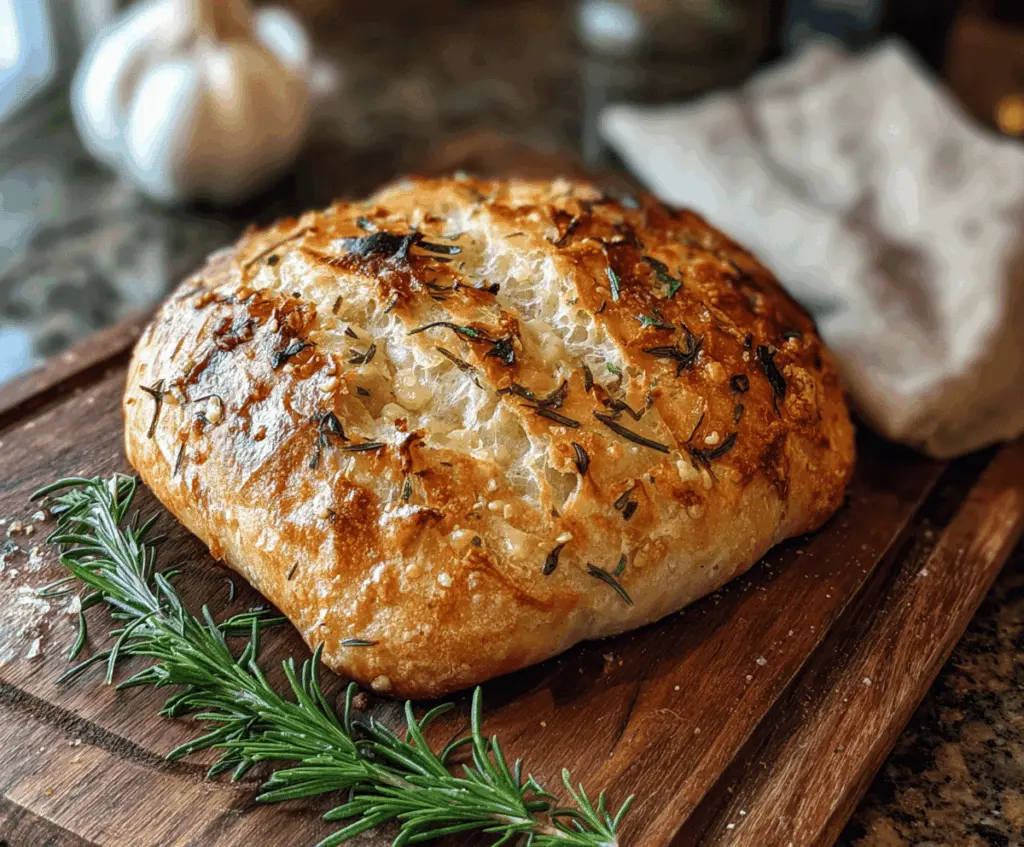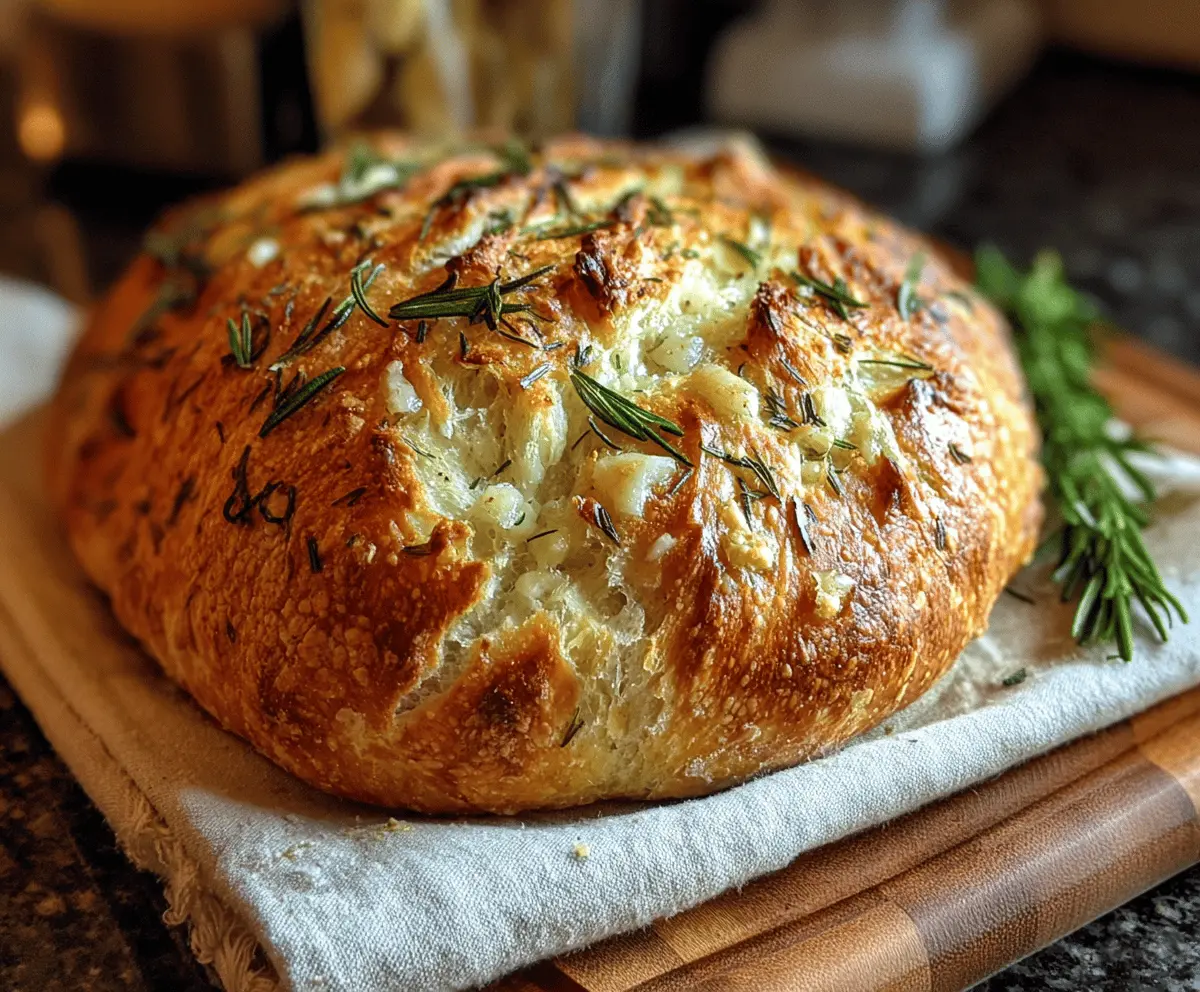
Rustic No-Knead Rosemary Garlic Bread
Rustic No-Knead Rosemary Garlic Bread is a simple and delicious loaf that brings the comforting smells and flavors of fresh herbs and garlic right into your kitchen. The crust is…
Tip: save now, cook later.Rustic No-Knead Rosemary Garlic Bread is a simple and delicious loaf that brings the comforting smells and flavors of fresh herbs and garlic right into your kitchen. The crust is nicely golden and crunchy, while the inside stays soft and chewy. The rosemary adds a lovely piney aroma, and the garlic gives just the right kick without being too strong.
I really love making this bread when I don’t have a lot of time or energy because it doesn’t need kneading. You just mix the dough, let it rest, and then bake it up—easy as that! It’s one of those recipes that feels like magic because the bread comes out tasting like it took hours and hours to make, even though it didn’t.
My favorite way to enjoy this bread is warm, with a little bit of butter melting on top or dipped in olive oil. It’s also great alongside soups or salads and makes any meal feel extra special. If you ever share this with friends or family, be prepared for everyone to ask for the recipe!
Key Ingredients & Substitutions
All-purpose flour: This flour works great for a chewy yet soft texture. If you want a nuttier flavor and denser crumb, try bread flour as a substitute.
Rosemary: Fresh rosemary adds a lovely aroma. If you don’t have fresh, dried rosemary works too. Use about one tablespoon of dried for every three tablespoons fresh.
Garlic: Fresh garlic gives a strong, vibrant flavor. If fresh isn’t available, garlic powder can be used but add less—start with 1/2 teaspoon and adjust to taste.
Olive oil: It adds richness and helps keep the bread moist. You can swap with melted butter for a slightly different flavor.
How Can You Bake No-Knead Bread Without It Sticking or Losing Shape?
The no-knead dough is very sticky because of the high hydration, so handling it gently is key.
- Flour your hands and the surface well before shaping to keep the dough from sticking.
- Use parchment paper to easily transfer the dough to your pot without deflating it.
- Preheating the Dutch oven traps steam, which creates a good crust and helps the bread rise.
- Don’t remove the lid too soon; baking covered keeps moisture inside for a softer crumb.
- Once you remove the lid, watch the crust carefully to avoid burning while it crisps up.
Equipment You’ll Need
- Large mixing bowl – big enough to hold sticky dough and let it rise comfortably.
- Wooden spoon or silicone spatula – perfect for stirring sticky dough without a mess.
- Kitchen scale or measuring cups – to get your flour and water just right.
- Parchment paper – makes transferring the dough to the hot pot super easy.
- Heavy Dutch oven or oven-safe pot with a lid – traps steam for a crispy crust and soft inside.
- Cooling rack – lets your bread cool evenly and keeps the crust crisp.
Flavor Variations & Add-Ins
- Swap rosemary for thyme or oregano for a different herby twist that pairs well with garlic.
- Add 1/2 cup grated Parmesan or sharp cheddar into the dough for a cheesy surprise inside.
- Mix in 1/4 cup chopped sun-dried tomatoes for a touch of sweetness and color.
- Include a pinch of red chili flakes with the garlic to give the bread a gentle spicy kick.
Rustic No-Knead Rosemary Garlic Bread
Ingredients You’ll Need:
For the Dough:
- 3 cups all-purpose flour
- 1/4 teaspoon instant yeast
- 1 1/4 teaspoons salt
- 1 1/2 cups warm water (about 110°F / 45°C)
- 3 tablespoons fresh rosemary, roughly chopped (plus extra for topping)
- 3 cloves garlic, minced (plus extra for topping)
- 2 tablespoons olive oil (plus extra for drizzling)
- Coarse sea salt for sprinkling on top
How Much Time Will You Need?
The total time for this recipe is about 14 to 20 hours because of the long rise. Prep time is just 15 minutes to mix everything together. Then the dough will rest and rise for 12 to 18 hours. After shaping, it needs another 1 to 2 hours of rising before baking, which takes around 45 minutes. Though it’s a long wait, active work is very short and easy!
Step-by-Step Instructions:
1. Mix the Dough:
In a large bowl, combine the flour, instant yeast, and salt. Pour in warm water and olive oil. Stir everything together with a wooden spoon until it forms a sticky dough. Add the chopped rosemary and minced garlic, then mix gently to combine.
2. First Rise:
Cover the bowl with plastic wrap or a clean kitchen towel. Let the dough rest at room temperature for 12 to 18 hours. It should become bubbly and grow noticeably.
3. Shape and Second Rise:
After the dough has risen, generously flour a clean surface and turn the dough out onto it. Flour your hands lightly and shape it gently into a rough round loaf, being careful not to press out all the air. Place the dough on parchment paper, cover it again, and let it rise for 1 to 2 hours until puffy.
4. Bake the Bread:
Preheat your oven to 450°F (230°C) with a heavy Dutch oven or oven-safe pot inside. When hot, carefully remove the pot from the oven. Using the parchment paper, lift and place the dough into the pot. Drizzle some olive oil on top, then sprinkle extra minced garlic, rosemary sprigs, and coarse sea salt.
Cover with the lid and bake for 30 minutes. Remove the lid and bake for another 15 to 20 minutes until the crust is deeply golden and crisp.
5. Cool and Serve:
Take the bread out of the pot and transfer it to a wire rack. Let it cool slightly before slicing. Enjoy warm with butter, olive oil, or alongside your favorite meal!
Can I Use Dried Rosemary Instead of Fresh?
Yes, you can! Use about one-third the amount of dried rosemary compared to fresh since dried herbs are more concentrated. So for 3 tablespoons fresh, use 1 tablespoon dried. Add it to the dough just like the fresh rosemary.
What If I Don’t Have a Dutch Oven?
No worries! You can bake the bread on a preheated baking stone or heavy baking sheet. To create steam (which helps the crust), place a shallow pan of hot water on the bottom rack of your oven while baking.
How Should I Store Leftover Bread?
Keep leftover bread in a paper bag or loosely wrapped in a kitchen towel at room temperature for up to 2 days to maintain the crust’s crispness. For longer storage, slice and freeze the bread, then toast or warm slices when ready to enjoy.
Can I Make This Bread Without Garlic?
Absolutely! Simply omit the garlic if you prefer a milder flavor or have dietary restrictions. The rosemary alone will still give the bread a wonderful aroma and taste.

